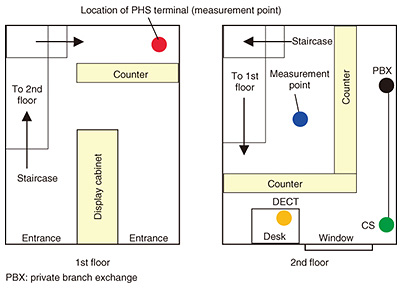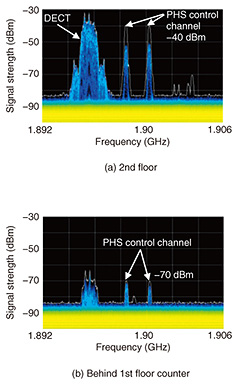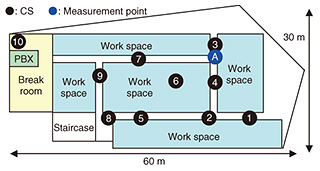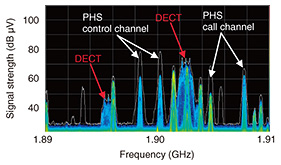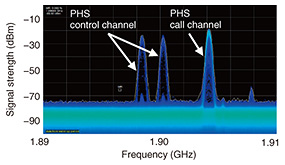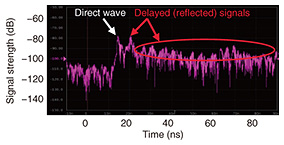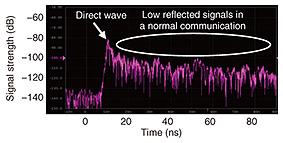 |
|||
|
|
|||
|
Practical Field Information about Telecommunication Technologies Vol. 15, No. 12, pp. 67–71, Dec. 2017. https://doi.org/10.53829/ntr201712pf1 Case Studies of Problems in Digital Cordless PhonesAbstractThis article describes various faults that were occurring with digital cordless phones and the investigations and countermeasures implemented to solve the problems. This is the forty-third article in a series on telecommunication technologies. This contribution is from the EMC Engineering Group, Technical Assistance and Support Center, Maintenance and Service Operations Department, Network Business Headquarters, NTT EAST. Keywords: digital cordless phone, PHS, radio signal 1. IntroductionThe diversification of business formats and means of communication in offices, manufacturing plants, and elsewhere has led to the use of digital cordless phones (1.9-GHz band) such as the Personal Handy-phone System (PHS) [1] as a supplement to conventional fixed-line telephone sets. More recently, the introduction of digital cordless phones based on the new Digital Enhanced Cordless Telecommunications (DECT) system (1.9-GHz band) has been progressing in addition to PHS. As a result, digital cordless phones are being used with increasing frequency in diverse environments such as plants and warehouses in addition to offices. However, this enhanced deployment of digital cordless phones is being accompanied by problems associated with the customer’s environment, radio signal level, and interference. In short, the causes of faults in the use of digital cordless phones are becoming more diverse, making early recovery from such faults and the improvement of service quality a matter of urgency. In this article, we introduce recent case studies of problems in digital cordless phones handled by the Technical Assistance and Support Center. 2. Case study 1: Communication failure inside a store (αNX II business phone)The first case study involves a communication failure. The problem is first described, and the results of the investigation and the countermeasures implemented are explained. 2.1 Overview and reportA customer using digital cordless phones (PHS: 1.9-GHz band) connected to NTT’s αNX II business phone system reported a problem in which calls could not be made or received within the customer’s retail store (behind the counter on the first floor: see Fig. 1). In this configuration, one cell station (CS) is located near the window on the second floor, and two PHS terminals are in use. Replacing the terminals did not solve the problem.
2.2 Results of measurement and cause of failureA spectrum analyzer (Keysight Technologies N9020A) was used to measure the signal strength at the center of the store on the second floor and behind the counter on the first floor. The CS is located near the center of the store on the second floor, so we were able to observe signals that had sufficient strength (–40 dBm) at that measurement point (Fig. 2(a)). DECT signals were also observed in addition to PHS signals. At the measurement point behind the counter on the first floor, the signal strength from the CS installed on the second floor was found to have dropped to as low as –70 dBm (Fig. 2(b)).
The results of the above measurements led us to infer that this problem occurred because the PHS terminals were being used at a location that was too far away from where the CS was installed, resulting in insufficient signal strength at the terminal usage location. 2.3 CountermeasureWe received the customer’s consent to add a CS near the location where the PHS terminals were being used (near the first floor counter). We found that stable communications could be achieved with the signal strength of –65 dBm at the terminal usage location. 3. Case study 2: Phone noise in office (PBX EP74)The second case study involved phone noise. We report here on the problem encountered by the customer, the results of the subsequent investigation, and the recommended countermeasure. 3.1 Overview and reportA customer using a private branch exchange (PBX) (EP74) reported noise and dropped calls when using digital cordless phones (PHS terminals) accommodated by the PBX. A total of 10 CSs were installed throughout the floor, and 109 PHS terminals were being used (Fig. 3). Replacing terminals failed to solve the problem.
3.2 Results of measurement and cause of failureWe used a spectrum analyzer (Keysight Technologies N9020A) to measure the radio signal environment in the PHS band below CS 3 (see Fig. 3). In this measurement, DECT signals could be observed in addition to PHS control-channel and call-channel signals (Fig. 4).
The results revealed that the DECT and PHS signals were interfering with each other. This led us to infer that the cause of noise in the phones was this interference between DECT and PHS signals. Although PHS and DECT have functions for mutually avoiding interference, it can be inferred that a high channel utilization rate may leave no empty channel available for interference avoidance, resulting in the occurrence of interference and dropped calls. 3.3 CountermeasureTo prevent this phone noise from occurring, we recommended to the customer that no DECT terminal be used or alternatively that the DECT terminal be exchanged with a terminal using frequency bands other than the 1.9-GHz band (2.4-GHz digital cordless phones, 5-GHz Wi-Fi devices, etc.). 4. Case study 3: Dropped calls in a food plant (αNX II business phone)We explain a problem involving dropped calls as the third case study. The results of our investigation into the problem and the countermeasure to rectify it are also reported. 4.1 Overview and reportDropped calls and line disconnections were occurring in digital cordless phones (PHS: 1.9-GHz band) accommodated by NTT’s αNX II-L business phone system. The customer reported that such problems occurred frequently in the processing room of the food plant depicted in Fig. 5. Measures such as replacing terminals or adjusting signal power failed to solve the problem.
4.2 Results of measurement and cause of failureWe used a spectrum analyzer (Tektronix RSA6114A) to measure the radio signal environment at the measurement point within the processing room (see Fig. 5). The PHS signal strength was found to be sufficiently strong, and no interfering signals were observed (Fig. 6).
The processing room has wall and floor surfaces and machinery made of stainless steel and other types of metal, so we considered that reflected signals might have an effect on call quality. We measured such reflected signals with a network analyzer (Keysight Technologies E5071C) and observed the delay (reflected) signals of nearly the same strength as direct waves and long-delay (reflected) signals of 80 ns or longer (Fig. 7). When compared with a location enabling normal communications (Fig. 8), the above results revealed the existence of a multipath.
The results led us to infer that dropped calls in the processing room were caused by reflected signals. 4.3 CountermeasureThe customer’s processing room with its wall and floor surfaces and machinery made of stainless steel and other metals is conducive to the generation of reflected waves, resulting in a critical environment for radio signals. We explained to the customer that such an environment made the use of digital cordless phones difficult and proposed the use of fixed-line phones. To prevent future problems, we recommended that call tests be performed before introducing a new service to see whether dropped calls or other problems might occur. 5. ConclusionIn this article, we introduced recent case studies of problems in digital cordless phones handled by the Technical Assistance and Support Center. With the proliferation of various types of digital cordless phones, the causes of failures are becoming increasingly diverse. The EMC Engineering Group of the Technical Assistance and Support Center aims to achieve prompt resolution of problems related to digital cordless phones and to contribute to the smooth provision of communication services. To this end, it is actively engaged in technology dissemination activities through technical support, development, and technical seminars. Reference
|
|||









